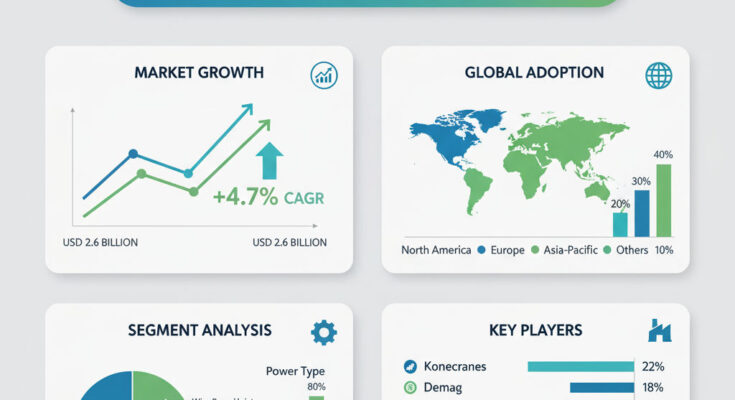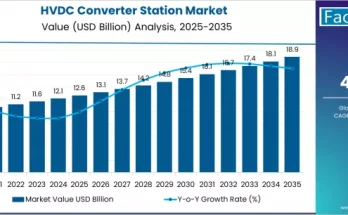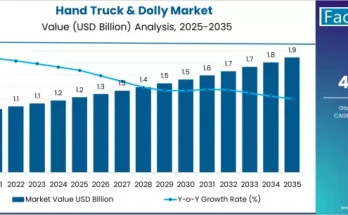The electric hoist market is on a steady upward trajectory as industries around the the world continue to modernize their material-handling operations. Analysts estimate the market was valued at around USD 2.6 billion in 2025. Forecasts point to the market growing to approximately USD 4.1 billion by 2035, representing a compound annual growth rate (CAGR) of about 4.7% over the the ten-year period. This growth reflects rising demand for reliable, automated, and high-performance hoisting solutions across manufacturing, construction, warehousing, logistics, and heavy-industry applications.
Market Drivers and Growth Catalysts
A number of key factors are fueling the expansion of the the electric hoist market. First, industrial automation and Industry 4.0 adoption are prompting manufacturers to integrate hoists with digital monitoring, predictive maintenance, and remote control capabilities. These features reduce downtime, improve safety, and help optimize operational efficiency in high throughput environments. Second, infrastructure and construction activity remain strong globally, especially in emerging economies, driving demand for hoists with higher load capacities and precise lifting control. Third, warehousing and logistics growth — including growth in e-commerce and fulfillment centers — requires hoisting solutions for mezzanines, automated storage systems, and loading operations. Fourth, stricter safety regulations in material handling and lifting operations are pushing companies to replace or upgrade manual or less controlled hoists with electric alternatives that offer load sensors, overload protection, and remote/automated control.
Segmentation: Product Types, Capacity & End Uses
In terms of product type, electric hoists are commonly categorized into wire rope hoists and chain hoists (and specialty variants). Wire rope hoists tend to dominate for heavy loads and long lifts due to their strength, durability, and suitability for continuous high-capacity operations. Chain hoists often serve lighter or medium duty lifting tasks with more compact designs and cost effectiveness. In lifting capacity terms, hoists are segmented into light loads (under ~5 tons), medium loads (5–20 tons), and heavy duty applications (above 20 tons), covering a wide range of industrial and construction requirements.
When it comes to end use industries, manufacturing tends to account for a large share, as assembly lines, material handling, and heavy equipment production all rely on hoists. Construction is another major segment, where hoists are required for structural assembly, lifting of materials, and installation activities. Warehousing, logistics, ports, and shipping operations use hoists extensively for loading/unloading, storage handling, mezzanine and automated systems. Energy, marine, oil & gas and mining also contribute increasing demand, given the need for heavy lifting and precise control in harsh or constrained environments.
Regional Insights & Market Opportunities
Geographically, Asia-Pacific is among the fastest growing regions for electric hoist adoption. Rapid industrialization, infrastructure projects, manufacturing expansion, and logistics hubs in countries like China, India, Southeast Asia, and others drive strong demand for hoisting equipment. Because labor costs are rising and automation is growing, many operations in the this region are adopting electric hoists for improved efficiency and safety.
North America and Europe remain mature markets with high standards for safety, equipment certification, and automation integration. In these markets, electric hoists are often upgraded to meet regulatory requirements, digital integration (remote monitoring, IoT, predictive maintenance), and higher safety or environmental standards. These regions also serve as major markets for premium, high-performance hoists. Latin America, the Middle East and Africa are emerging as secondary growth regions as infrastructure and manufacturing capabilities develop, regulatory frameworks improve, and companies invest in industrial modernization.
Competitive Landscape & Key Players
The market is competitive with a combination of global original equipment manufacturers (OEMs), specialized hoist makers, and regional suppliers. Key industry players include brands with strong reputations in lifting equipment, cranes, hoists and material handling solutions. These companies are increasingly investing in smarter hoist systems with digital control, safety sensors, and integration with facility management systems. Many also provide after-sales services, training, technical maintenance, and full solution packages including hoist + crane + control systems to support industrial customers.
Challenges and Market Constraints
Despite the promising outlook, there are several constraints and challenges. Electric hoists may require substantial upfront investment, especially for heavy-capacity or automated systems, which can be a barrier for smaller or cost-sensitive customers. Logistics, shipping, and installation of large hoist units (especially wire rope systems) can be complex, requiring trained technicians and infrastructure support. Additionally, regional regulations around safety, certification, and lifting standards vary, requiring manufacturers to ensure compliance with multiple domestic or international standards. Another challenge is competition from manual or less expensive alternatives in some low-cost markets, or substitution by alternative lifting solutions (like hydraulic or pneumatic hoists) in specific applications.
Forecast & Strategic Recommendations
Looking forward to 2035, the market is expected to continue growing steadily. Demand will be driven by automation, warehouse modernization, infrastructure construction, and stricter safety norms. For manufacturers and stakeholders, some strategic priorities should include:
-
Developing hoist systems with smart features (IoT monitoring, remote control, predictive maintenance, digital load tracking) to differentiate offerings.
-
Expanding manufacturing or distribution capacity in high-growth regions such as Asia-Pacific and emerging markets to meet rising demand.
-
Offering flexible hoist capacity options (light, medium, heavy duty) tailored to different industry needs.
-
Providing turnkey solutions that bundle hoist + structural crane or system + installation + maintenance services to reduce customer complexity.
-
Ensuring compliance with regional lifting standards, certifications, and safety regulations to enable market access across countries.
Browse Full Report: https://www.factmr.com/report/electric-hoist-market
Editorial Perspective
The electric hoist market is evolving from traditional lifting tools into integrated, intelligent lifting systems that support modern industrial, logistics, and infrastructure operations. As industries automate, warehouse spaces expand, and safety standards tighten, hoists are becoming key assets rather than mere equipment. Success in this market will go to those who can combine product engineering excellence, digital integration, regional expansion, and regulatory compliance. Over the next decade, electric hoists will play a pivotal role in enabling efficient, safe, and scalable lifting operations across industries worldwide.



